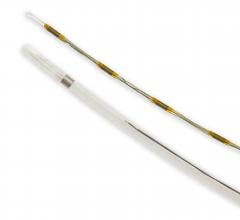July 22, 2013 — A new report issued by the American College of Cardiology (ACC) and developed in collaboration with 10 other professional societies provides detailed criteria to help clinicians optimize the appropriate use of certain noninvasive vascular tests when caring for patients with known or suspected disorders of the venous system. Also included are first-time recommendations for when and how to use these tests to plan for or evaluate dialysis access placement.
“Vascular lab testing is central to the care of patients with most peripheral vascular disorders, but appropriate use criteria (AUC) for these [technologies] have lagged behind those for cardiac testing,” said Heather Gornik, M.D., FACC, cardiologist and vascular medicine specialist at the Cleveland Clinic and chair of the writing committee. “With this report, we now have multidisciplinary criteria upon which we can start maximizing the quality and appropriateness of what we do in the vascular lab every day.”
Vascular testing is often used to help evaluate possible venous thromboembolism, which is the third most common cardiovascular disease, after coronary disease and stroke, and includes deep vein thrombosis (DVT) as well as pulmonary embolism (PE). These conditions can be fatal and result in hospitalizations and long-term complications. Therefore, identifying the best methods for detecting clots in the veins early on can be lifesaving, Gornik said. “But we must know that we are ordering the right test for the right reasons,” she added.
The new report offers comprehensive, at-a-glance guidance on when – and when not – to refer patients for vascular laboratory testing (for example, duplex ultrasound and physiological testing using blood flow sensors) to help detect such problems as venous insufficiency, varicose veins, blood clots in the veins the leg, arm or abdomen, and pulmonary embolism. These criteria are a follow-up to the group’s previously issued guidance evaluating the use of the vascular laboratory for diagnosing and monitoring the arterial side of the circulatory system.
To develop the criteria, a diverse writing group including representatives from vascular medicine, cardiology, interventional radiology, orthopedic and vascular surgery identified 116 clinical scenarios when the use of vascular testing might be considered. A separate group of experts then used a rating scale to determine whether vascular testing for each circumstance would be appropriate, possibly appropriate or rarely appropriate.
Overall, vascular studies were deemed appropriate when clinical signs and symptoms are the main reason for testing. For example, if a patient has swelling, discoloration or pain in one leg, experts agree that it is reasonable to order a duplex ultrasound evaluation of the legs to determine whether there might be a DVT or clot. In contrast, it is rarely appropriate to use these tests to screen for DVT in patients without symptoms – even in those who are more prone to clotting or who have had an extended intensive care unit or hospital stay, recent (major) orthopedic surgery or a positive D-dimer blood test.
“Vascular ultrasound is now the best, most accurate test we have for diagnosing DVT and it has clear advantages, including its low risk to the patient with no exposure to radiation or contrast dye and the fact that it is less expensive relative to other tests,” Gornik said. “But a lot of screening ultrasounds are done indiscriminately for asymptomatic patients, and we found there is little evidence to support that practice.”
The report also shows the vascular lab plays a central role in evaluating patients with chronic venous insufficiency, a condition in which blood pools in the veins of the legs and causes swelling, non-healing ulcers and worsening varicose veins. This condition can seriously affect a person’s quality of life and mobility. The writing committee also rated pre-operative vascular testing for preparing a dialysis access site as appropriate as long as it was done within three months of the procedure; however, vascular testing was rarely appropriate for general surveillance of a functional dialysis fistula or graft unless there is some indication of a problem (e.g., palpable mass or arm swelling, low volume flow during dialysis sessions).
Unlike with arterial disease — for example, for follow-up of small aortic aneurysms or narrowing or blockages of the carotid artery — there are far fewer clinical scenarios in which vascular testing is deemed useful for repeat monitoring of venous disease, and further research is needed.
“There is also growing need for comparative and cost-effectiveness research of vascular laboratory testing in the care and diagnosis of patients with DVT and PE,” Gornik said. “There are also a number of controversial areas that have not yet been fully explored, which we have outlined.”
One example is whether patients with blood clots in their calf should be treated with blood thinning medication versus duplex ultrasound surveillance. Another area requiring more research is how ultrasound of the veins in the legs and arms can be used as part of clinical algorithms to diagnose and manage PE (blood clots in the lungs). Similarly, the role of duplex ultrasound for follow-up after venous procedures (e.g., venous stenting procedures) or to assess dialysis access maturity is not as well established.
These AUC were developed in collaboration with the American College of Radiology, American Institute of Ultrasound in Medicine, American Society of Echocardiography, American Society of Nephrology, Intersocietal Accreditation Commission, Society for Cardiovascular Angiography and Interventions, Society of Cardiovascular Computed Tomography, Society for Interventional Radiology, Society for Vascular Medicine and Society for Vascular Surgery. The authors stress these criteria should not supersede sound clinical judgment for individual patients.
For more information: www.cardiosource.org


 November 21, 2022
November 21, 2022 




